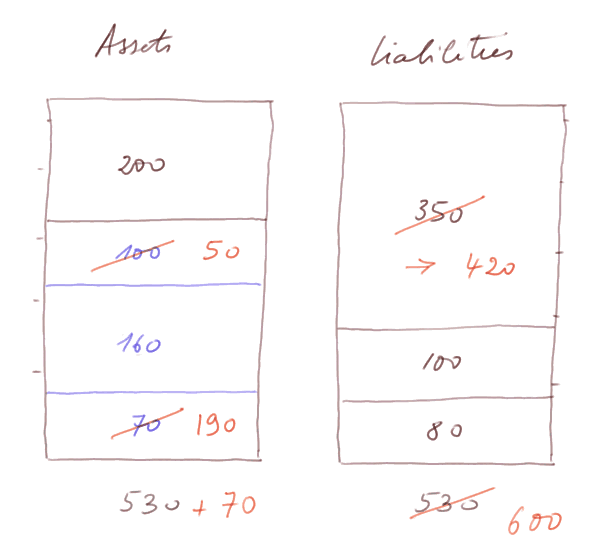General accounting
X. 37. Big measures in the balance sheet
Video
Now that we have learned how to prepare an Income statement and a Balance sheet, it is important to take a larger view of these documents, in particular of the balance sheet.
Indeed, the Income statement is the easier to understand. It is simply, over a period of time, the Sales - the Costs to create the sales.
And let's not forget that all the items presented in the income statement are values, not necessarily cash. For instance, a sale may be on credit, in which case an IOU comes into the firm, but no cash.
So, let's consider the following balance sheet:
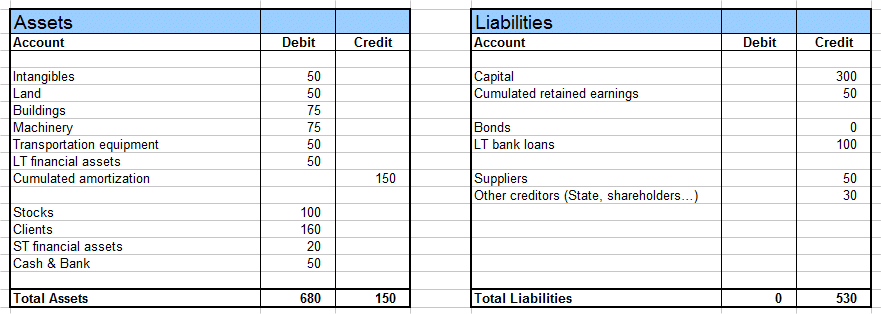
We are familiar with the various items on the asset side and on the liability side. If you don't feel at ease with them yet, you ought to go back to the previous lessons.
Let's just stress that the assets represent what the firm owns.
And the liabilities show the structure of financing of the assets (i.e. of the firm):
- some financing comes from the owners: initial capital and past profits retained into the firm (i.e. not distributed as dividends)
- some financing was borrowed from lenders (banks or the financial markets): it has a yearly cost, called the interest charges. These costly debts are somehow money rented by the firm.
- some financing comes for free: the operations of the firm, and the credit it has with suppliers and other outfits, create some "borrowings" which cost nothing.
First of all, when we study a BS, it is useful to make a graphical representation, using boxes proportional to the various items.
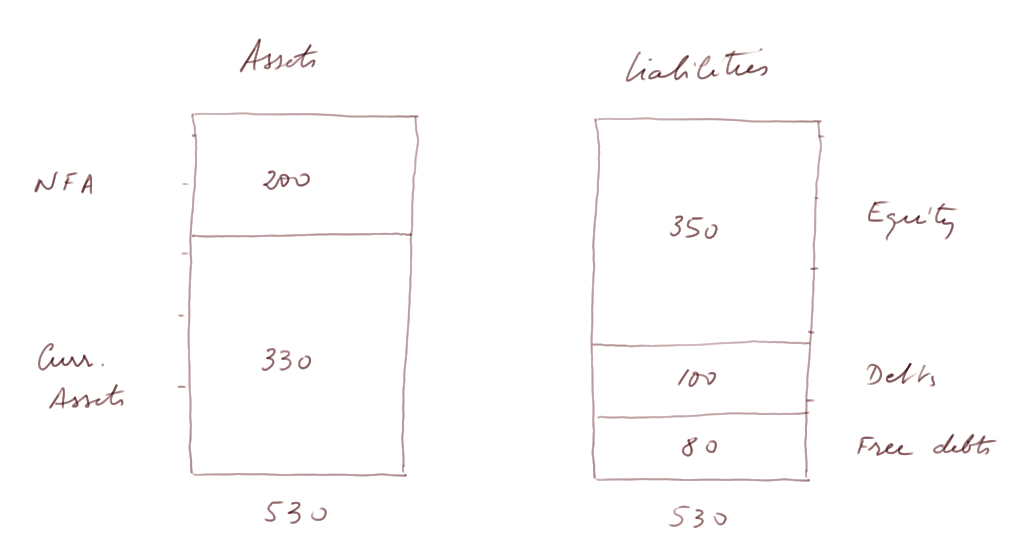
"Equity" is another name for "Net worth", that is: initial capital + sum of retained earnings. And when we talk about Debt (or Debts) without specifying, we usually mean "Costly debts".
With this graphical representation, we get a better perception of the relative importance of the various items making up the balance sheet.
Here we see, on the asset side, that the firm has more current assets (stocks, clients, and cash and assimilated) than net fixed assets.
And on the liability side, we see that the firm is financed mostly with Equity (= value coming from the shareholders). The costly debts (called simply "Debt") are only 22% of the sum [Equity + Debt]. In other words, the firm is not much indebted.
Capital employed. The quantity [Equity + Debts] is an important big measure in the balance sheet. It is called the "capital employed", abbreviated CE.
The CE are in red in this figure:
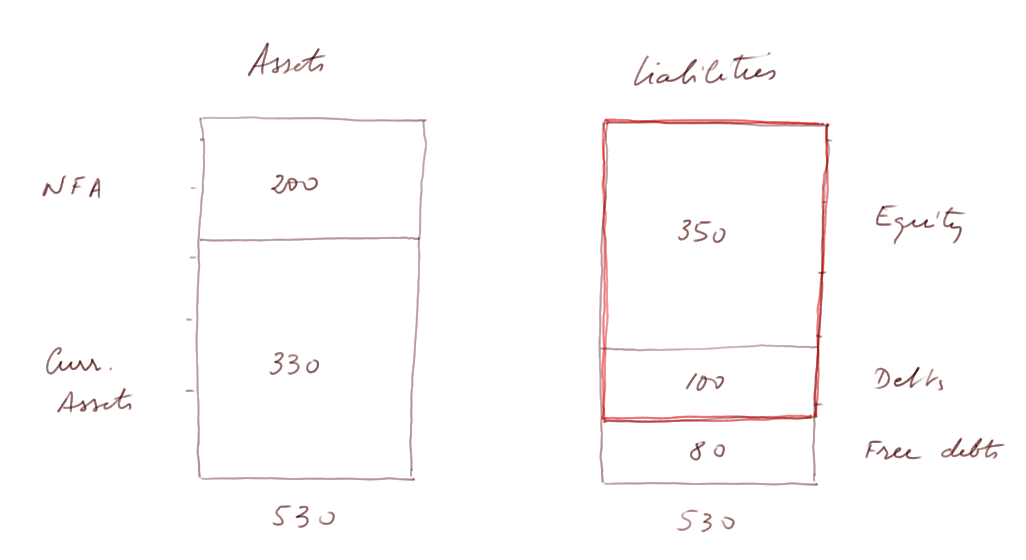
The capital employed represent the funds which the firm obtained from the external world (later on + auto-financing), and which must be remunerated.
The Debt must be remunerated with yearly interest charges paid to the lenders, according to a schedule agreed upon in the loan contract.
The Equity must be remunerated with dividends paid to the shareholders.
There is less constraint, however, with the dividends because it is the directors (i.e. representatives of the owners) who decide whether to pay dividends or not. There is no obligation to do so, unlike for Debt.
Even if there is a profit during the past year, the directors may decide to keep it in the firm. In that case it increases the Equity; it is, therefore, not value that the owners give up, they just don't receive it in the form of cash.
Notice that the choice to pay dividends or not is not directly related to the profit or loss of the past year. It is possible to give dividends, whether the firm made a profit or a loss, as long as there will be cash in the till when it actually intends to make the payment. There are firms which try to pay steady dividends to their shareholders, even when the Net results from one year to the next are not steady. Some other firms never pay dividends because they grow and they make a profitable use of the extra funds employed represented by the retained profit. For instance, from 1986, when it was introduced in the stockmarket, until 2006, Microsoft paid no dividends to its sharehorlders.
Another name of the "Capital employed" is the "Funds employed".
To summarize, remember that the important part of the liabilities, describing the financing of the firm, is the "funds employed" (or "capital employed"), which require an effort to get. They partially finance the assets. The rest of the financing comes from the free credit generated by the operations.
Working capital. We just saw that the financing of the firm (that is, of its assets) is made with the "capital employed" (CE) plus the free credit.
In the most usual situation, the CE are higher than the Net Fixed Assets. And we say that the CE finance the NFA plus a part of the Current Assets.
The Working Capital is by definition CE - NFA.
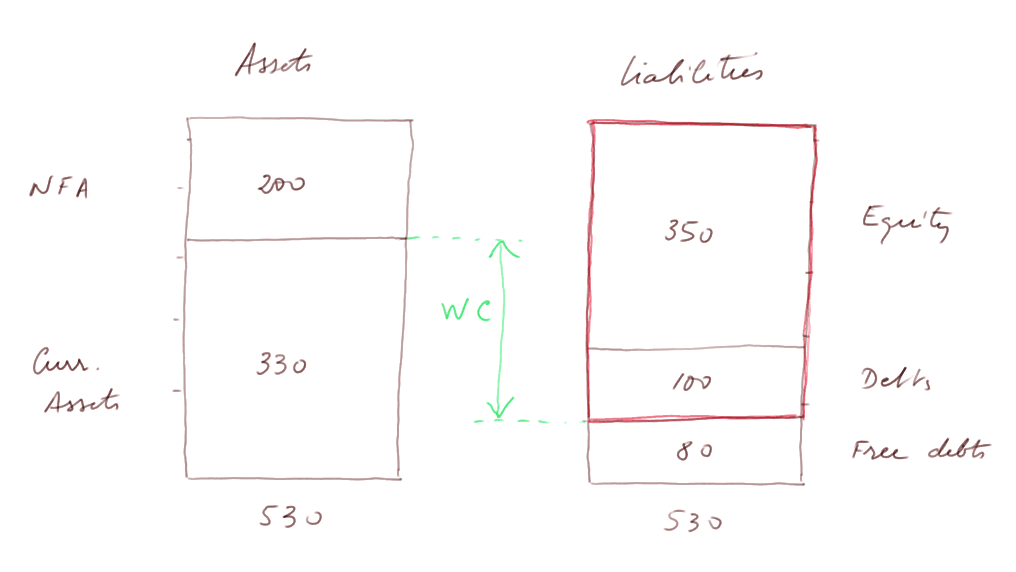
Here the working capital equals 250.
Notice that it is not really meaningful to say that such and such liability finances a specific part of the assets. What is true is that
all the liabilities = all the assets
However, it is customary to say that the CE finance all the NFA and an extra part.
It is natural to call this extra part the "Working capital", because it is the part of the Capital employed which finances a part of the Current assets (seen as more "working" than the "fixed assets").
Notice that the WC can be negative, which is usually a dangerous situation, because then the current assets (more liquid than the fixed assets) are less than the "current liabilities" (if we equate the free debt to liabilities due soon, which is almost but not exactly correct).
More on liquidity and current assets compared to current liabilities in the lessons on liquidity and on ratios.
At the foundation of the firm, or right after it, when we have spent our capital and possible funds borrowed from the outset, but before the operations began, the liabilities are entirely the "capital employed" (since there is normally no free debt from creditors yet), and the asset side is made of all the Fixed and Current assets necessary to begin operations (land, bldg, machinery, stocks, and cash).
So we see that when we start a firm we must plan to get enough capital (from shareholders, and possibly from lenders) to finance not only the Fixed assets, but also assets which will "turn" or "work": the stocks and cash (and soon there will also be clients IOU requiring financing). These assets are the working capital.
Later on, when we have some free credit, the working capital becomes the CE minus the NFA.
When the operations begin we hopefully begin to make profit. But remember that profit is not cash. It is possible to make sales (and profit), but sales on credit, and therefore profit "on paper" only.
To finish this lesson on a higher view of the balance sheet, let's see once more the impact on the balance sheet of the most basic operation of the firm.
Suppose at some date t we have the following BS
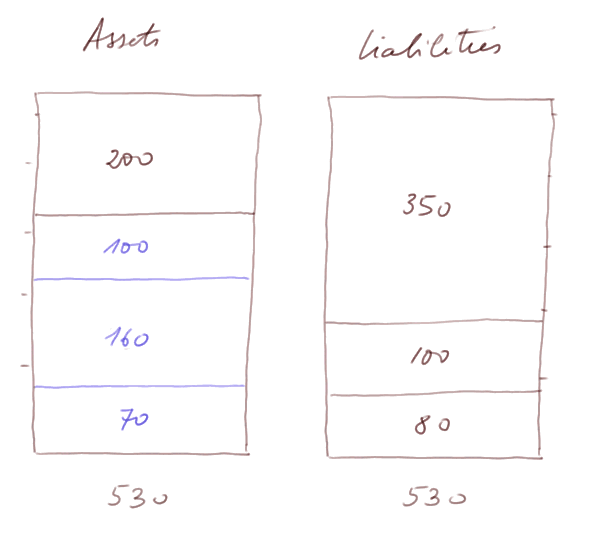
(In blue, on the assets side, are: 100 of stock, 160 of clients IOU's, and 70 of cash and assimilated.)
And let's look at a single operation: we take from the stock an item which has value (to us) 50, and we sell it for 120. We therefore make an elementary profit of 70. (Of course this is not a real "income statement" corresponding to the operation, since there would also be costs, but let's disregard them).
What's the impact on the BS?
Answer:
- the stock goes down from 100 to 50.
- the cash (if it is a cash sale) increases from 70 to 190
- on the liability side, the Equity which was 350 becomes 420
